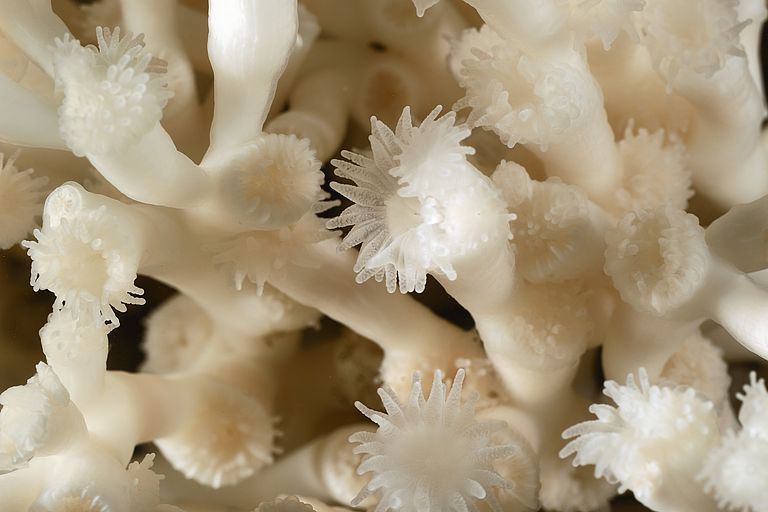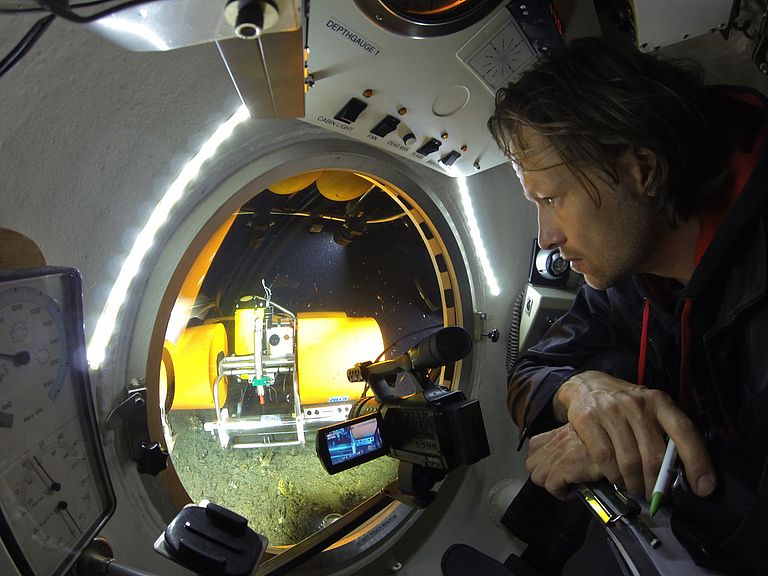Cold-Water Corals Document Environmental Changes
GEOMAR scientists develop new climate archive
Increasing concentrations of carbon dioxide (CO2) in the oceans can be a threat for marine life. Since an increased CO2 content of the water lowers the so-called pH of the water, it becomes more acidic. Marine organisms that build their shells or skeletons from carbonate are thus impaired by the carbonate-dissolving acidity of the ocean. A better understanding of seawater chemistry helps to assess management processes in the carbonate system of the ocean from the past and for the future. Dr. Jacek Raddatz from GEOMAR Helmholtz Centre for Ocean Research Kiel, together with colleagues from GEOMAR and from Belgium, has examined the relationship between the pH of seawater and the structure of corals. The results have now been published in the international journal Biogeosciences.
For their study, the researchers sampled live coral of the species Lophelia pertusa as well as the surrounding seawater in the northeastern Atlantic and the Mediterranean. They determined the pH of the water samples to obtain an accurate picture of the coral’s habitat. Drill samples were taken from the corals which were then subjected to more detailed laboratory tests. The scientists were primarily interested in the content of the elements uranium and calcium, the so-called U/Ca ratio. By comparing the two analyses, the researchers found something really interesting: "The relationship between the U/Ca ratio and the pH is very tight," says Dr. Raddatz, author of the current study. "Consequently, we were able to analyze coral samples and calculate the past pH level from the U/Ca ratio based on these findings. This is a new method for cold-water corals and could be an alternative to boron isotope analysis which is an extremely time-consuming process. In the future, the combination of both methods (U/Ca ratios and boron isotope) will give us a more detailed understanding of the seawater chemistry," the scientist says. Currently it is difficult to assess the impact of the ocean acidification we measure today. A look into the past could help. How did these systems change in the past and what impact did it have on cold-water corals? These questions Dr. Raddatz and his colleagues will continue to explore.
The newly released study is a continuation of work by GEOMAR colleague Dr. Sascha Flögel that was already published in the journal Deep-Sea Research earlier this year. There Dr. Flögel, together with colleagues from the UK and Belgium, examined which environmental conditions are ideal for recent cold-water corals. The researchers analyzed samples from Norway, Scotland, Ireland, France, Spain, Mauritania and the Mediterranean. Their results give an overview of which are the preferred physical and chemical conditions for the growth and occurrence of cold water corals in the field. "A crucial parameter for the growth of cold-water corals in the eastern Atlantic and the Mediterranean is the concentration of inorganic carbon in near-bottom water," says Dr. Flögel. The term inorganic carbon encompasses various carbon types. "This level differs regionally and therefore defines where cold water corals can grow," Dr. Flögel continues. In addition to the content of inorganic carbon, the scientists also determined the pH of the water at the various locations. These results formed the basis for the new study, published in the journal Biogeosciences.
The relationship between the pH of seawater as a measure of increasing ocean acidification and the distribution of cold-water corals remains an exciting area of work. As part of the overall project, Dr. Raddatz and several colleagues have studied corals from the Challenger Mound in the northeastern Atlantic. The Challenger Mound is covered by numerous cold-water corals which, in their entirety, cover the past three million years. "An examination of this archive in terms of changes in pH of the seawater would be an exciting challenge," Dr. Raddatz summarized. "Our newly developed method to reconstruct pH values of the past offers a unique opportunity."
Original publications:
Raddatz, J., Rüggeberg, A., Flögel, S., Hathorne, E. C., Liebetrau, V., Eisenhauer, A., and Dullo, W.-Chr. (2014): The influence of seawater pH on U / Ca ratios in the scleractinian cold-water coral Lophelia pertusa, Biogeosciences, 11, 1-9, 1863-1871, http://dx.doi.org/10.5194/bg-11-1863-2014
Flögel, S., Dullo – W.-Chr., Pfannkuche ,O., Kiriakoulakis, and Rüggeberg, A. (2014): Geochemical and physical constraints for the occurrence of living cold-water corals. Deep-Sea Research II: Topical Studies in Oceanography, 99, 19-26, http://dx.doi.org/10.1016/j.dsr2.2013.06.006
Raddatz, J., Rüggeberg, A., Liebetrau, V., Foubert, A., Hathorne, E. C., Fietzke, J., Eisenhauer, A., and Dullo, W.-Chr. (2014): Environmental boundary conditions of cold-water coral mound growth over the last 3 million years in the Porcupine Seabight, Northeast Atlantic, Deep Sea Research Part II: Topical Studies in Oceanography, 99, 227-236, http://dx.doi.org/10.1016/j.dsr2.2013.06.009
High-resolution images:
Cold-water coral Lophelia pertusa in Trondheim fjord (Norway). Photo: Solvin Zankl
Dr. Sascha Flögel in the JAGO submersible during a dive in Trondheim fjord (Norway) in 2013 Photo: Jürgen Schauer, GEOMAR
Contact:
Maike Nicolai (Communication & Media), Phone: +49-431 600 2807, mnicolai(at)geomar.de




